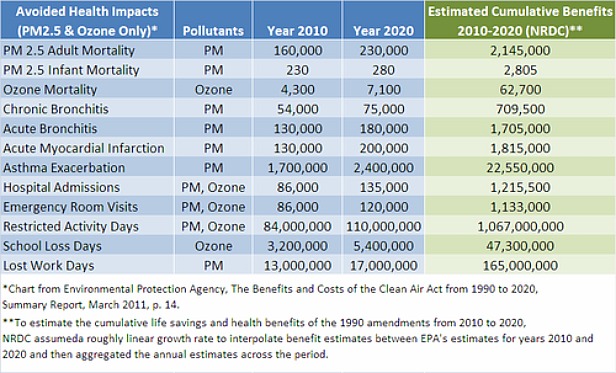Cross-posted from the Natural Resources Defense Council.
Times were great in the 1990s real estate market: If you got in right before the market took off, and cashed out just before it crashed, you could have made a whopping 75 percent return on your money. But … it was all paper; chances are high the house wasn’t 75 percent nicer. And, for most people, returns were lower than 75 percent, some punishingly negative. It all depended on when you bought and sold.
But what if you found out you could get a guaranteed real return over 2,400 percent in one year? And that returns only increased over time and were “bubble proof”? You’d say “there must be a catch,” and you’d be right. There are two. First, you can’t buy this investment from Wall Street. Second, you have to rely on the good will and decency of your representative — and these days, that is not reliable.
What’s the product? The Clean Air Act.
A new report released yesterday by the Environmental Protection Agency (EPA) finds benefits of the 1990 amendments to the Clean Air Act (CAA) exceeding costs by a ratio of 26 to 1 in 2010, and 30 to 1 in 2020. And the report just looks at health and environmental benefits. As I detail further below, evidence strongly suggests we can expect substantial improvements in economic performance as well.
Yet, in a full-on attack against the EPA, opponents of clean air and public health in Congress are trying to sabotage the CAA and prevent the EPA from doing its job (click here, here, here, and here). It is worse than irresponsible: It is negligent.
First let’s start with the end goal, protecting the public.
The extensively peer-reviewed report (click here, here, and here) documents the following health and environmental benefits from the 1990 amendments:
- In 2010 alone, we gained approximately $1.3 trillion in public health and environmental benefits, for a cost of only $50 billion. That’s a value worth more than 9 percent of GDP, for a cost of only 0.4 percent of GDP. For comparison, we spent approximately 5 percent of our GDP on the defense budget in 2010.
- The ratio of benefits to costs in 2010 is more than 26 to 1.
- In 2020, we will have a staggering gain of approximately $2 trillion in benefits, at a cost of $65 billion. That’s a value worth more than 14 percent of today’s GDP, for an expenditure of only 0.46 percent. The ratio of benefits to cost is more than 30 to 1.
The table below shows the EPA’s estimates for the associated health benefits in 2010 and 2020, as well as cumulative figures estimated by NRDC. Following that is a figure from the EPA’s report showing how benefits relative to costs increase over time.
(Click here for a summary of past benefits).
Economic growth and jobs:
In addition to the health and environmental gains estimated in the report, we can also expect significant improvements in jobs, economic output, and competitiveness. Earlier this month, the EPA provided the exhaustive review of the evidence to Congress, summarized below:
1. Job growth and increased economic output:
Because environmental protection is more labor-intensive than the rest of the economy, environmental regulation on average generates net increases in jobs. Some highlights:
 Looking at four of the most heavily regulated industries (pulp and paper, refining, iron and steel, and plastic), Richard Morgenstern et al. (2002, Journal of Environmental Economics and Management) estimated a net increase in employment of 1.5 jobs per $1 million in environmental spending over alternative expenditures.
Looking at four of the most heavily regulated industries (pulp and paper, refining, iron and steel, and plastic), Richard Morgenstern et al. (2002, Journal of Environmental Economics and Management) estimated a net increase in employment of 1.5 jobs per $1 million in environmental spending over alternative expenditures.- Roger Bezdek et al. (2008, Journal of Environmental Management) also found a net employment gain from environmental spending, noting that “environmental protection has grown rapidly to become a major sales-generating, job-creating industry — $300 billion per year and 5 million [direct and indirect] jobs in 2003.” These jobs are shared widely across many states, and often located in the same highly industrialized regions where unemployment is particularly high. Jobs created span a wide spectrum of wage earners: factory workers, engineers, computer analysts, accountants, clerks, ecologists, truck drivers, consultants, and many more.
- By 2008, the U.S. environmental technologies industry was supporting 1.7 million direct jobs (2010, Environmental Business Journal). Air pollution control equipment alone generated revenues of more than $18 billion in 2007 (U.S. Department of Commerce).
- Data from the International Brotherhood of Boilermakers indicates that the number of boilermakers in the U.S. increased by 6,700 — or 35 percent — as a result of the CAA.
- The Institute for Clean Air Companies estimated that complying with just one standard created approximately 200,000 person-year jobs in the past seven years (about 29,000 full time jobs each year on average).
- These results reported by EPA are consistent with many studies on clean energy and climate legislation (click here, here, here, and here).
2. Innovation and a more productive workforce:
The environmental technology sector is very real, and growing. According to the heads of the European Environmental Agencies in 2005, the annual world market for environmental goods and services will surpass $700 billion by 2010, making it comparable to the aerospace and pharmaceutical industries. And thanks to our strong environmental laws, the U.S is well-positioned in this market, exporting more to other countries than it imports, and generating more economic output overall:
According to the Department of Commerce:
[T]he U.S. is regarded as a world leader in many environmental technology categories including: engineering, design, construction, consulting services; … stationary and mobile air pollution monitoring and control equipment; … and information systems/software for environmental management analysis.
Environmental technology exports have grown dramatically from less than $10 billion in 1990 to about $44 billion in 2008, and the U.S. share of foreign environmental technology markets has been increasing (Department of Commerce International Trade Administration). In 2008, the U.S. had a net trade surplus of $11 billion in environmental technologies, helping the U.S. balance of trade.
A series of studies led by Dale Jorgensen at Harvard University found that implementing the CAA actually increased the size of the economy (contrary to industry predictions). Even after accounting for capital being diverted away from other uses, improved health and a more productive workforce increased net economic output. Reduced pollution led to fewer lost work, school, and restricted activity days, fewer fatalities, fewer hospital visits and other medical expenses, and avoided expenditures on education needed to address diminished IQ levels caused by neurotoxins. The research concluded that by 2010, GDP was approximately 1.5 percent higher than it would otherwise have been since 1970, and this excludes all of the environmental benefits (e.g. ecological preservation) not accounted for in GDP estimates.
Forces hostile to the EPA and the public health it is entrusted to protect argue for cutting its budget and regulatory authority in the name of fiscal responsibility. But a deeper look at the numbers tells us exactly the opposite: Doing so would be negligent, unethical, and fiscally unsound. Health and environmental benefits alone exceed costs by orders of magnitude. On top of these are real gains in economic performance. Contrary to what clean air opponents want us to believe, strengthening and protecting the CAA is good for people and the economy. It creates jobs, increases the health and productivity of the workforce, increases the U.S. balance of trade, and helps preserve the environment. Rather than attacking the EPA for doing its job, we should be improving and protecting it. It’s an investment with unparalleled returns.




